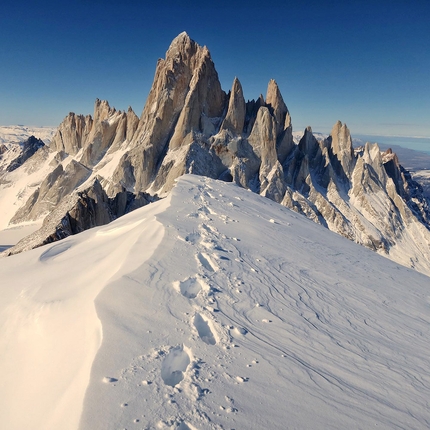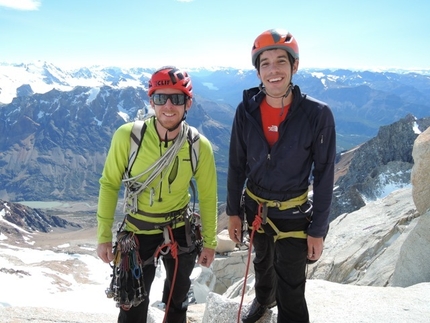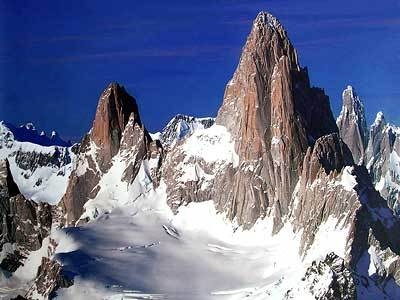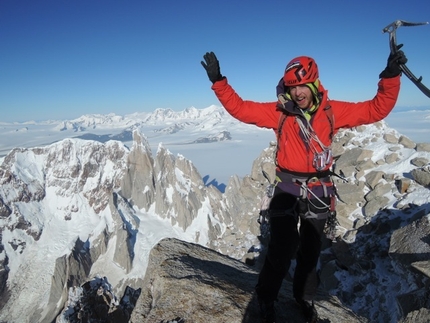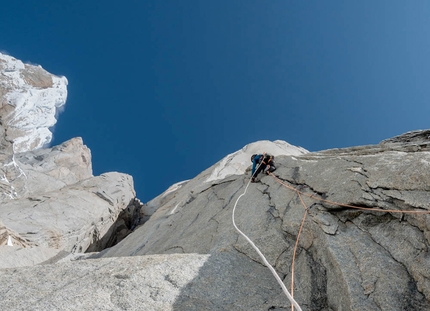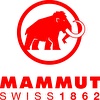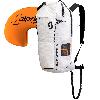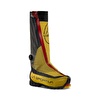Sean Villanueva and the magical Moonwalk Traverse of Fitz Roy skyline solo in Patagonia

 1 / 8
1 / 8 Sean Villanueva
Sean Villanueva
As reported last Friday, from 5 to 10 February 2021 Belgian climber Sean Villanueva O’Driscoll completed the first solo of the Fitz Roy traverse, climbing the famous Patagonian skyline completely on his own and climbing the +4000m altitude difference with difficulties up to 6c and 50° totally free. Prior to this enormous undertaking, only Tommy Caldwell and Alex Honnold had managed to complete the traverse, from 12 to 16 February 2014. Villanueva’s feat was described by Colin Haley as "the most impressive solo ascent ever done in Patagonia," while Rolando Garibotti explained that despite being unimaginable, ”Reality seems to have this way of always surpassing imagination." Here is the full interview with Villanueva after his magical Moonwalk Traverse.
Sean, if we’re not mistaken you’ve been in Patagonia for quite a while now!
Yeah I’ve been in here for a year and a month now, I arrived in Patagonia with Nicolas Favresse to do some climbing and my original plan was to stay until the end of March. Nico was scheduled to leave a few weeks earlier and he actually barely made it back before the lockdown. I on the other hand got stuck, initially completely, then at a later stage I suppose I could have made it back to Belgium by contacting the embassy, but it seemed like a lot more hassle than it was worth because things in Europe were bad, and I was over here, in one of the most beautiful places on the planet. I felt like a kid locked up in a giant playground, in such a fairy tale land that I didn’t really see the need to go back. So I just stayed.
When did you get the idea of doing the traverse? And why solo?
Well actually I’ve been wanting to do something on my own for quite a while, I guess I’ve just been really, really inspired by Silvia Vidal, by her expeditions, by her philosophy and mindset when she goes on these huge trips all on her own. I’ve been wanting to try something similar but unfortunately in the past I’ve been blessed with some of the best climbing partners you could wish for ;-) I’m telling you, it’s really hard to go off on your own when your climbing partner constantly comes up with some good plans! But during winter, while being stuck here, I slowly began to realise that this could be my opportunity to try something alone. This was maybe the time to try the Traverse I thought, although at first it felt really daunting and completely unrealistic.
How come?
Mostly because of the weather conditions here. But the seed was sown in my mind and I decided it wouldn’t hurt looking at the guidebook and try piecing everything together and see what it might look like. You know, winter nights are long and cold here… so I spent many of them just leafing through the guidebook, analysing different ways of piecing it together, and then one day I started believing that maybe it would be possible after all. At first I thought that I’d need about 10 days to do it because of all the rope soloing involved, which is very slow, but you never get a 10-day window here in Patagonia. Then I decided that if I’d get a 6-day window I’d give it a go. And as it happened, right on my birthday I got that 6-day window so I thought I might as well try and see how far I could get.
What was your goal?
As I said, just see how far I could get. In reality what I really wanted was to have an experience up there on my own, and in the end this turned out to be absolutely magical. It felt as if everything fell into place, right from the start with the idea that evolved slowly. And mentally I started preparing myself, knowing full well that it would never happen, because you never get a 6-day weather window. But all the stars aligned and I think I was just very, very lucky.
One could argue that you were very lucky with the weather Sean, but that’s just one part of the equation. You created your luck. This traverse is something you’ve been working towards, indirectly perhaps, for the last 20 years, it’s the culmination of a lifetime climbing the hardest routes in the harshest conditions and you fully deserve this success. Out of interest, why did decide to do it in the reverse order compared to Tommy Caldwell and Alex Honnold?
Because it was something new. I thought like that it would be more adventurous. The only reason is because it hadn’t been done before and I felt there would be more question marks involved.
You started on the 5th of February and finished on the 10th. Was that pretty much as planed?
Yeah well I didn’t really have a plan, all I wanted to do was see how far I could get. So I had no real expectations and I definitely didn’t know how fast I would be. All I wanted to do was try and see.
What style of ascent did you choose?
I set off really heavy, I had a lot of gear and a lot food. I definitely wasn’t very efficient strategically or logistically. With the weight of my bag there was no way I’d be doing any free soloing, it was just too heavy, perhaps somewhere in the region of 30kg at the start, I’m not all too sure because I didn’t weigh it. I had 10 days worth of food, I had a tent, a sleeping bag, a big down jacket and obviously my tin whistle! A lot of gear!
Which meant…
My tactics were to rope solo everything that involved climbing, and free solo anything the involved scrambling. At the start I had a backpack and a haulbag, so I would climb with the backpack which contained all the light stuff such as my down jacket, the sleeping bag and tent, and I’d haul the haulbag with all the heavier stuff. It was a lot of work and very inefficient to switch strategies, packing everything into one bag for scrambling, then repacking everything into two bags for hauling and climbing. But on the second day my haulbag broke, the bottom opened up and I was lucky I didn’t lose anything, but I couldn’t use the haulbag anymore and from then on for any climbing I was forced to climb up, rap back down and jumar back up with the backpack on my back. It was a mix of different strategies and I was kind of making it up as I went on.
Apart from the weather, was there anything you were worried about?
Well on the very first day I had three core-shots on my rope because of a rockfall, and as soon as I saw that I was convinced I wasn’t going to make it. Three core-shots on the first day… I thought “there’s no way my main rope is going to survive all the way to the end.”
Many would have turned back at that point Sean
Yeah that’s what everybody keeps telling me! But at the time I didn’t really care that much, my goal as I said was to see how far I could get, so I just taped the rope up and thought I might as well continue. So yes, I was worried about how long the rope would hold out, especially because as I progressed I got more core shots; every day I would put on more new tape and continue. I tried to be very careful with it, making sure it wouldn’t get wet as this would destroy it more quickly. And whenever I got to a taped section during a rappel I’d try and unweight the rope and feed the core shot through the belay device. I’d just try and be kind to my rope, speak to it, be nice to it. And it was nice to me across the whole Traverse. On the last rappel, the very very last one, the sheath came off and exposed the core for about a meter! So my rope gave up, but only on that last rappel!
Don’t tell us that it’s less than 9mm…
Yeah, well actually it’s 8.9! But I did have a 6mm tag line as a backup had I really needed it.
Sean tell us a bit about the weather?
It was OK. There were some windy days, and there was one very cold day, but it was absolutely beautiful, there was a sea of clouds and I was constantly climbing above and between the clouds. It was absolutely stunning, mystical almost. Then one day was really windy but I was lucky because the face I was climbing was protected from the wind. But when rappelling down Fitz Roy I had to stop early because of the wind, it seemed too dangerous to continue on down as the ferocious gusts could have picked up the rope and thrown it behind a flake, way off route, so I decided to stop early and sleep slept on the ledge. The next day the wind had died down and I continued on down, this turned out to be a wise decision. Besides the wind, I was really lucky with the temperatures, they were always OK, never too cold.
You’re certainly no newcomer to Patagonia. How many of these mountains had you climbed before?
Fitz Roy, Guillaumet, Mermoz, Poincenot and Saint Exupery, the others I tagged were new to me. I climbed 10 peaks in total I guess, Alex and Tommy did some of the smaller peaks like I did, we didn’t do precisely the same.
You mentioned your hallmark tin whistle. How often did you play it?
I played it on every summit, every bivy, and on some of the cols. Such a great way to relax!
Sean apart from completing the traverse solo, which in itself defies imagination, you also happened to climb it all free!
Yeah well there isn’t actually any really hard climbing. But I just got really, really lucky with conditions; almost all the climbing I did was on the south faces which get almost no sun at all, but the routes weren’t all icy, they weren’t all wet. Of course, there were some icy and wet sections, but they were very short. So all the climbing I did was free, but obviously I had the rappels which you have to bear in mind.
Did climbing it all free not just compound the difficulties?
Free climbing has always been my game, it made complete sense to be free climbing up there even if I was on my own. I have nothing against aid climbing, but my game has always been free climbing and this was the most natural thing to do.
You mentioned rappells. Right towards the end, on Guillaumet, you witnessed rockfall on the route you were about to abseil off
Yes that’s correct. It was the last day and it was pretty windy. My original plan had been to rappel down the west face but that’s the windiest face, so I decided to rappel down Amy, which is probably one of the most popular routes on Guillaumet, since it faces east and is protected from the wind. I thought I’d play it safe and go down that route, even though it finishes on the glacier and I wasn’t totally comfortable with the idea of walking on the glacier on my own. But I’d noticed some tracks and thought I’d be able to follow them, that would give me a little bit more of safety margin. So I placed the ropes and was just about to start rappelling when a huge block in the middle of Amy, the size of half a car perhaps, thundered down the route. It was sunny and warm so things were coming off the mountain, and this block flew down the route and landed on the glacier, started an avalanche that wiped out all the tracks. When I saw that I thought “OK, well I’m not going down that way!”
Definitely not!
No, well actually that was a pretty good thing because I ended up going down the Brenner-Moschioni route, which follows Guillaumet all the way to the end. It’s the real skyline. Had I descended Amy the line wouldn’t have looked so good on the topo ;-)
It was descending there that your rope gave up?
I struggled a bit with the wind so I just took my time, putting the ropes in a bag so they wouldn’t fly away, and managed to go all the way to end of the skyline. Another good thing about the Brenner-Moschioni route is that there’s no glacier, I was back with firm ground beneath my feet. Yeah the rope had done it’s job and I was happy to be back down. From then on all I had to do was walk slowly back to civilisation.
You’d celebrated your 40th during those days up in the mountains. How was that?
It felt great. It was the day I did Poincenot and Kakito, I stopped early at La Brecha and enjoyed the rest of afternoon knowing I’d climb Fitz Roy the next day. It was nice, there was definitely a sense of celebration, but to be honest what really struck me was when I got back down, seeing all the birthday messages from friends and family, and the response I’ve received from the climbing community. It’s been really, absolutely overwhelming. But as I said, it feels like everything just fell into place really naturally. You know, I spent over a year here, got stuck here and then just enjoyed being in magical El Chalten, this idea popped up, I had lots of time to think about it, to visualise it, then this window showed up right on my birthday, my 40th… I don’t know, somehow it seemed like it was meant to be.
Most certainly. Talking about visualisation; you mediated every morning during your ascent. Is this something you do often?
No, not at all, normally we don’t have the time. But here I did, I’d sit in my tent for about a quarter of an hour and bring my mind right into the present, focus on my breathing, feel the sensations, relax my body, listen to nature. I’d wake up before dawn and do this in the dark, nothing too long though, just enough to bring my mind into the present. Then I’d have breakfast and start climbing at first light.
How alone were you during this traverse? And did anyone know what you were up to?
I bumped into three other teams, one on Poincenot, one at La Brecha as they were coming off Fitz Roy, and one on the last pitches of Fitz Roy as they were rappelling down. At the moment it’s obviously very quiet in the mountains and obviously anyone I’d meet are locals with whom I’ve spent the year here.
Presumably these encounters were really special, both for you and for them!
Very definitely. They were really psyched for me and gave me really good energy. At first they couldn’t believe what I was doing, also because I hadn’t told anybody about my plan.
Really?
Yeah. I was afraid that no one would really understand, and think perhaps that I was completely crazy. I told Juan, on whose land I live, and I told Rolando Garibotti in the morning before I left.
That really is not very many people!
Yeah I guess so. But when I got back down, everybody knew before I even got back into town! And when I finally got there I got this huge welcome, everybody, everybody started cheering and celebrating.
Well we saw the video of you coming in through Horacio Gratton's door, fantastic!
Oh yeah. He lives in El Pilar, a few kilometres up the road, I stopped off there on my way down and had something to eat before going into town. It was a great moment.
You look happy. And also surprisingly fresh!
Thanks ;-) But as I said, I never really felt overly tired or completely broken on this climb, I just had really good energy levels all the way. I wasn’t sleeping much because the days were long, true, but I was just really happy and excited to be up there, all the time, it was just so special. And there’s perhaps also another reason I look OK: I got off Guillaumet at around, 2 or 3 o’clock and I could easily have walked back down to El Chalten that day, but as I walked back I didn’t feel like going back to town quite yet, so I stopped one more night at a bivy, at a beautiful camping spot, in order to soak it all in.
And get psyched for the next weather window?
Actually there’s a ventana coming soon, but I’m letting this one pass!
Sean Villanueva thanks: Patagonia, Petzl, SCARPA, Lyofood
Fitz Roy skyline, Patagonia
Aguja de l’S
Aguja Saint-Exúpery
Aguja Rafael Juárez
Aguja Poincenot
Aguja Kakito
Cerro Fitz Roy
Val de Bois
Aguja Mermoz
Aguja Guillaumet.



 Copia link
Copia link







 See all photos
See all photos